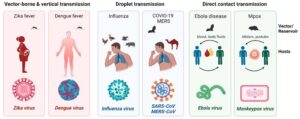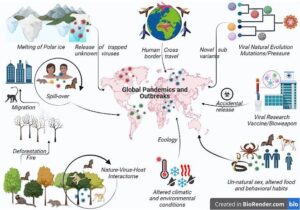Back to: MICROBIOLOGY 300 LEVEL
Welcome to class!
Hello bright star! I’m so happy to have you learning with me today. You’ve been doing an amazing job so far, and today’s lesson is another important one. We’ll be learning about some of the most well-known viruses in the world—names you’ve definitely heard before like HIV, COVID-19, and Ebola. These viruses may seem scary, but don’t worry—we’re going to understand them together in a simple, clear, and relatable way. Ready? Let’s begin!
Influenza, Hiv, Poliovirus, Ebola, COVID-19
Imagine waking up with a fever, cough, or feeling weak—and hearing that others around you feel the same. Viruses are often behind such outbreaks, affecting schools, communities, and sometimes the whole world. Today, we’ll learn about five major viruses—how they spread, what they do to the body, and why they’re important in public health. These viruses have shaped history and are still relevant today, especially in Africa.
Influenza Virus
Commonly known as the flu, this virus causes seasonal illnesses around the world.

Genetic Material: Single-stranded RNA (segmented)
Structure: Enveloped virus with surface proteins—haemagglutinin (H) and neuraminidase (N)
Transmission: Airborne droplets (coughing, sneezing), surfaces
Symptoms: Fever, chills, cough, body aches, sore throat
Fun Fact: Different strains are named like H1N1 or H3N2 based on their surface proteins.
Influenza spreads quickly and mutates often, which is why we get flu vaccines yearly.
HIV (Human Immunodeficiency Virus)
HIV is a life-changing virus that attacks the immune system, specifically white blood cells (CD4 cells).
Genetic Material: RNA (retrovirus)
Structure: Enveloped with enzymes like reverse transcriptase
Transmission: Through blood, semen, vaginal fluids, or from mother to child during birth or breastfeeding
Target: Immune system
Disease Caused: AIDS (Acquired Immunodeficiency Syndrome)
HIV weakens the body’s defence, making it hard to fight other infections. But with antiretroviral treatment (ART), people can live long, healthy lives.
Poliovirus
Poliovirus is small but mighty—it can cause paralysis, especially in children.
Genetic Material: Single-stranded RNA
Structure: Non-enveloped, icosahedral
Transmission: Faecal-oral route (dirty hands, contaminated water)
Target: Nervous system
Disease Caused: Poliomyelitis (can lead to paralysis)
Thanks to vaccines, polio is now very rare. Nigeria was declared polio-free in 2020 after years of hard work!
Ebola Virus
Ebola is known for causing deadly outbreaks in parts of Africa.
Genetic Material: Single-stranded RNA
Structure: Enveloped, long filamentous shape
Transmission: Direct contact with blood, body fluids, or contaminated materials
Symptoms: High fever, bleeding, vomiting, organ failure
Fatality Rate: Can be very high if not treated early
It spreads quickly and requires strong infection control to manage.
COVID-19 (Coronavirus Disease 2019)
COVID-19 is caused by the SARS-CoV-2 virus and changed the world in many ways.
Genetic Material: Single-stranded RNA
Structure: Enveloped with spike (S) proteins
Transmission: Airborne droplets, surfaces, close contact
Symptoms: Fever, cough, difficulty breathing, loss of smell, fatigue
Global Impact: Lockdowns, masks, vaccines, social distancing
COVID-19 showed us how fast a virus can travel and the power of global cooperation in fighting disease.

Think of Influenza as that visitor who comes every year during harmattan, makes you sneeze and sniffle, and then goes. HIV, on the other hand, is like an invader that hides inside the security system (immune system) and slowly breaks it down. Polio is like a silent intruder that targets children and can leave lasting damage. Ebola is like a wild fire—deadly, fast-spreading, and dangerous. COVID-19? That was the guest no one expected who turned the whole world upside down for months.
Summary
- Influenza causes seasonal flu and spreads through the air.
- HIV weakens the immune system and can lead to AIDS.
- Poliovirus targets the nervous system and causes paralysis.
- Ebola spreads through body fluids and can be deadly.
- COVID-19 spreads easily and caused a global pandemic.
Evaluation
- What makes HIV different from most viruses in terms of its effect on the body?
- How is poliovirus transmitted, and what part of the body does it affect?
- Mention two key symptoms of Ebola virus infection.
- Why do we need new influenza vaccines every year?
- What role did vaccines play in controlling COVID-19 and polio?
You’ve just conquered five of the most important viruses in modern history—what an achievement! Keep your mind open and your curiosity alive, because your knowledge can help create a healthier Nigeria and Africa. Here at Afrilearn, we believe in your greatness and can’t wait to continue this learning journey with you. You are doing wonderfully—see you in the next lesson!
